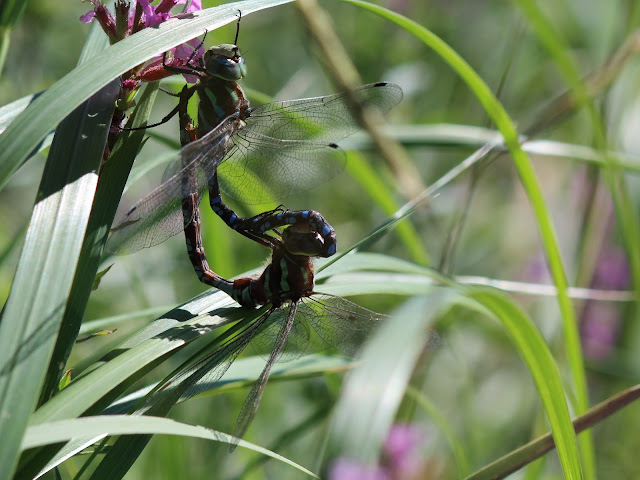I've managed to capture a few of them so far, although I'm not at all sure about my identifications, especially when it comes to the damselflies.
This is a dragonfly, and I'm fairly sure it is a Canada Darner (Aeshna canadensis). Its size and markings are fairly distinctive.
Here, in case you're not familiar with the birds and the bees of dragonflies (what a mouthful!), are a couple of Canada Darners in the progress of perpetuating their species. Really, the whole process of dragonfly reproduction is quite fascinating, if you feel inspired to read about it. Look it up!
This dragonfly is a saffron-winged meadowhawk (Sympetrum costiferum), I think, but I welcome corrections!

This dragonfly also looks almost identical to the one above, but it has a slightly yellowish haze to the wings at the point where they join the body. It also sat in a different resting position, with its tail pointed upward at about a 30 degree angle. Finally, the one above has black legs, and this one has brownish yellow legs. Thus, I believe this one below is the autumn meadowhawk (Sympetrum vicinum).

The picture below is a spreadwing (it alights with the wings spread out) and I believe it is most likely the lyre-tipped spreadwing (Lestes unguiculatus), but it might be the sweetflag spreadwing (Lestes forcipatus). I believe it's the former because the area behind its head is pale in colour, but I am only guessing based on photographs and field guides.
This one is, I believe, a female Eastern forktail (Ischnura verticalis). The females have a powdery blue appearance, which is quite different from the males.

This, I believe, is the male of the same species, Eastern forktail (Ischnura verticalis). My identification is supported by its green shoulder stripes and blue tipped abdomen, as well as the eye colour.





2 comments:
Beautiful insects! Great photography!
You found quite a variety of dragons and damsels! I started looking at them too late in life, so I often "discover" the same species several times. Still, I find them to be fascinating creatures even if I have trouble telling them apart. Thank you for your kind comments on my blog!
Post a Comment